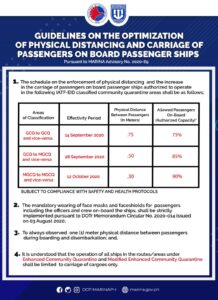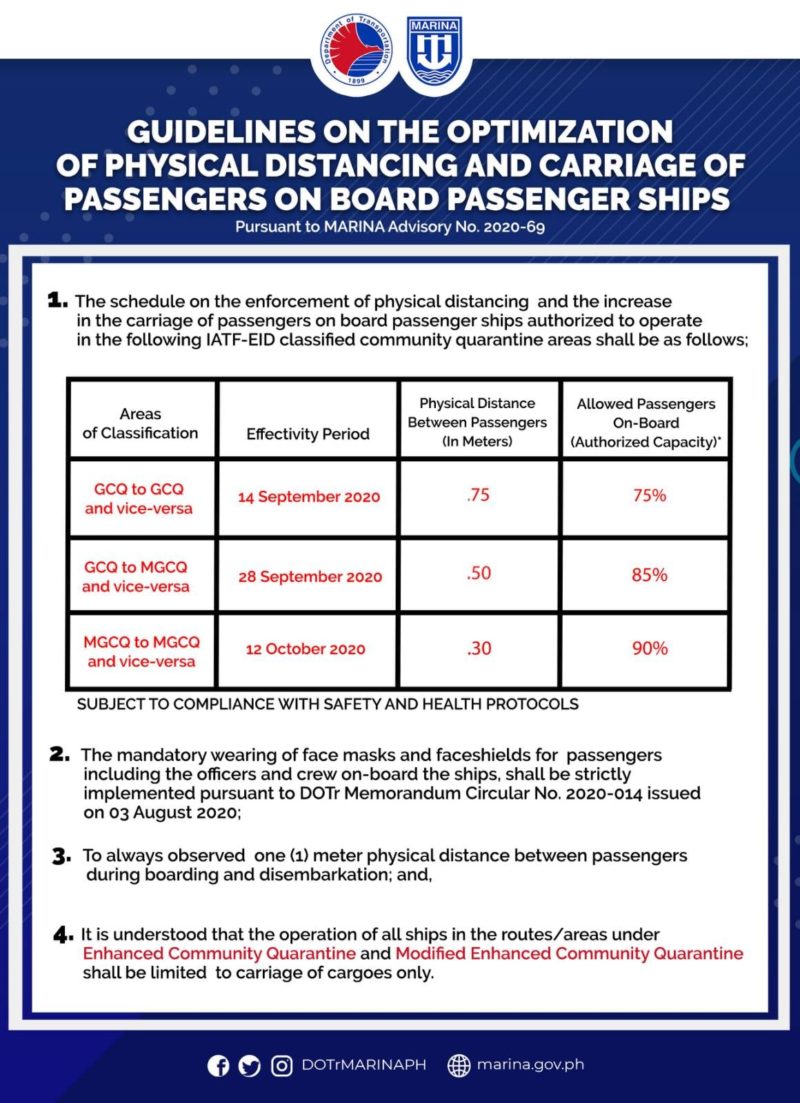 The Maritime Industry Authority (MARINA) has issued new guidelines on the optimum safe physical distance and number of passengers required on board passenger vessels.
The Maritime Industry Authority (MARINA) has issued new guidelines on the optimum safe physical distance and number of passengers required on board passenger vessels.
Under MARINA Advisory 2020-69 dated September 11, the physical distance required between riders and the number of passengers allowed on passenger ships will depend on the classification of community quarantine in the area the ships operate. The increase in authorized capacity is also subject to compliance with safety and health protocols.
The advisory was issued in response to Inter-Agency Task Force for the Management of Emerging Infectious Diseases (IATF) Resolution No. 67.
The IATF resolution adopted the proposal of the Department of Transportation (DOTr) and the Economic Development Cluster (EDC) to reduce the required physical distance between commuters in public transportation to increase ridership as the country moves to jumpstart recovery from the pandemic.
DOTr earlier explained that strict health protocols like the mandatory use among commuters of face masks and face shields are now being enforced to contain the spread of the coronavirus (COVID-19). As such, the one-meter physical distancing measure recommended by the World Health Organization can be safely adjusted to an initial 0.75 meter, then to 0.5 meter, and then later to 0.3 meter to increase ridership, DOTr said.
Agencies under DOTr started implementing reduced physical distancing of an initial 0.75 meter on September 14.
Under MARINA Advisory No. 69, a 0.75-meter physical distance between passengers and an authorized capacity of 75% is allowed for ships traveling to and from areas under general community quarantine (GCQ). This policy took effect on September 14.
A 0.50-meter physical distance between passengers and an authorized capacity of 85% is allowed for passenger ships operating in areas under GCQ and traveling to areas under the less strict modified GCQ (MGCQ), and vice versa, starting September 28.
Lastly, passenger ships traveling between areas under MGCQ are allowed a 0.30-meter physical distance between passengers and an authorized capacity of 90% starting October 12.
The mandatory wearing of face masks and face shields for passengers as well as ship officers and crew, and a one-meter physical distance between passengers during boarding and disembarkation will still be strictly implemented.
Ships operating on routes or in areas under the stricter enhanced community ECQ (ECQ) and modified ECQ must still carry only cargoes.
MARINA urged stakeholders to comply with and implement these ship safety rules and regulations and precautionary measures to promote safety habits to the public. It further noted that the health of the seagoing public and commuters necessitates safety protocols and policies.
DOTr assistant secretary for communications and commuter affairs Goddes Hope Libiran said the optimum physical distance in public transportation could change if an increase in the number of COVID-19 cases is recorded.





